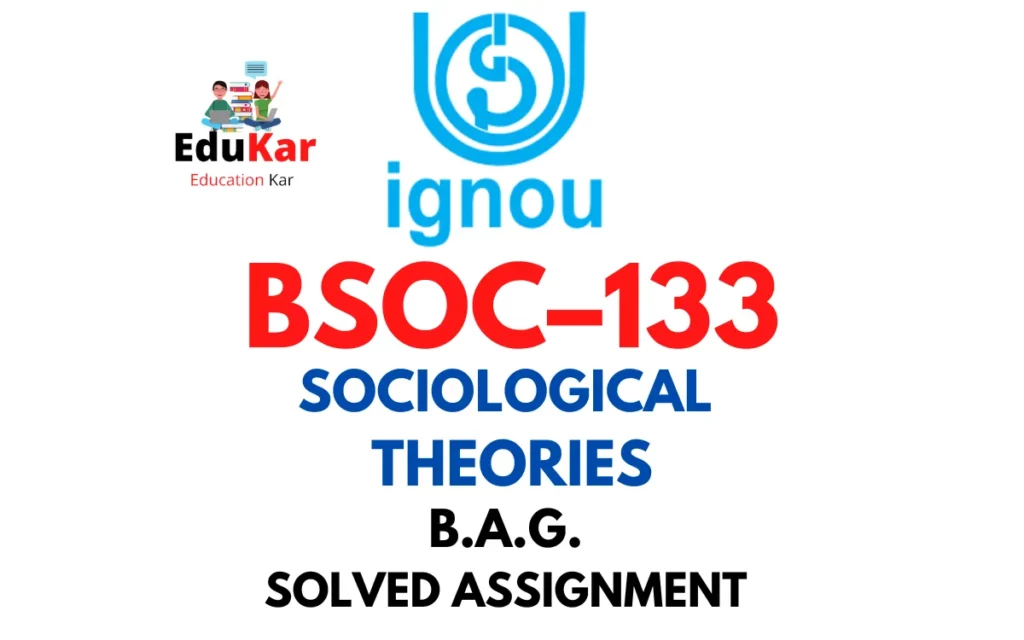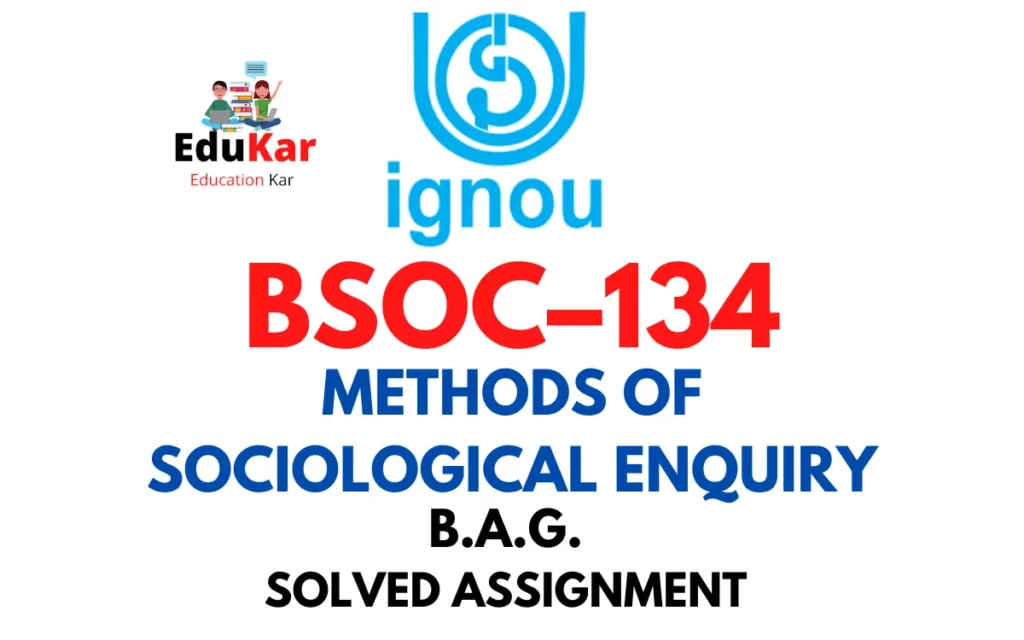Contents
- 1 Assignment I
- 2 Answer the following Descriptive Category Questions in about 500 words each. Each question carries 20 marks.
- 3 1. Compare and contrast Marx’s, Durkheim’s and Weber’s viewpoints on society, class and solidarity.
- 4 2. Discuss Marx’s perspective on division of labour.
- 5 Assignment II
- 6 Answer the following Middle Category Questions in about 250 words each. Each question carries 10 marks.
- 7 3. Discuss Émile Durkheim’s contribution to the sociology of religion.
- 8 4. What are the main characteristics of bureaucracy?
- 9 5. Explain Weber’s Theory of Social Action.
- 10 Assignment III
- 11 Answer the following Short Category Questions in about 100 words each. Each question carries 6 marks.
- 12 6. What is mechanical solidarity?
- 13 7. List the rules of observation of social facts.
- 14 8. What do you understand by is collective conscience?
- 15 9. Explain the concept of class.
- 16 10. Outline the laws of dialectic.

| Title | BSOC-133: IGNOU BAG Solved Assignment 2022-2023 |
| University | IGNOU |
| Degree | Bachelor Degree Programme |
| Course Code | BSOC-133 |
| Course Name | SOCIOLOGICAL THEORIES |
| Programme Name | Bachelor of Arts (General) |
| Programme Code | BAG |
| Total Marks | 100 |
| Year | 2022-2023 |
| Language | English |
| Assignment Code | BAG/BSOC 133/ 2022-23 |
| Last Date for Submission of Assignment: | For June Examination: 31st April For December Examination: 30th September |

Assignment I
Answer the following Descriptive Category Questions in about 500 words each. Each question carries 20 marks.
1. Compare and contrast Marx’s, Durkheim’s and Weber’s viewpoints on society, class and solidarity.
Ans: Marx, Durkheim, and Weber were three influential social theorists who contributed to the development of sociology as a distinct field of study. Each had different views on society, class, and solidarity. In this essay, we will compare and contrast their perspectives.
Karl Marx viewed society as being divided into two main classes, the bourgeoisie and the proletariat. The bourgeoisie were the owners of the means of production, while the proletariat were the working class who sold their labor to the bourgeoisie. Marx argued that capitalism was an exploitative system in which the bourgeoisie exploited the proletariat for their labor, paying them only enough to survive while keeping the surplus value created by their labor for themselves. This exploitation created a class struggle between the bourgeoisie and the proletariat, which Marx believed would ultimately result in the overthrow of the bourgeoisie and the establishment of a communist society.
In contrast, Emile Durkheim focused on the role of social solidarity in society. He argued that there were two types of solidarity, mechanical and organic. Mechanical solidarity was characteristic of traditional societies, where individuals had a strong sense of collective identity and shared beliefs and values. Organic solidarity, on the other hand, was found in modern societies, where individuals were more specialized and interdependent. Durkheim believed that modern societies were characterized by a division of labor, which led to greater interdependence between individuals and increased social solidarity.
Max Weber, on the other hand, focused on the role of ideas and values in shaping society. He argued that ideas such as religion and culture played an important role in shaping people’s beliefs and actions. Weber’s concept of the “Protestant ethic” illustrates this point. He believed that Protestantism, with its emphasis on hard work, thrift, and self-discipline, played a key role in the development of capitalism by creating a culture of individualism and rationality.
In terms of their views on class, Marx was primarily concerned with economic class, whereas Durkheim and Weber took a broader approach. Durkheim saw social class as being based on social status, while Weber saw it as being based on a combination of economic, social, and political factors. However, all three theorists recognized the importance of class in shaping society and social relations.
When it comes to solidarity, Marx and Durkheim had different views. Marx saw solidarity as being based on class interests, with the proletariat united in their struggle against the bourgeoisie. Durkheim, on the other hand, saw solidarity as being based on shared values and beliefs. Weber’s perspective was more complex. While he recognized the importance of shared values and beliefs, he also saw the role of power and domination in shaping solidarity.
2. Discuss Marx’s perspective on division of labour.
Ans: Karl Marx, a German philosopher, economist, and sociologist, was critical of the division of labor in capitalist societies, which he believed had a profound impact on social relations and economic inequality. According to Marx, the division of labor, which involves the specialization of labor and the separation of workers into different tasks and functions, is a key feature of capitalist societies, and it has a number of negative consequences for workers and society as a whole.
Marx argued that the division of labor in capitalist societies is based on the principle of efficiency, with the aim of maximizing productivity and profits. This means that workers are organized into hierarchies and are assigned specific tasks based on their skills and abilities, with little opportunity for creative or innovative work. As a result, workers become alienated from the products of their labor, as well as from the process of work itself, leading to a sense of powerlessness and dissatisfaction.
Marx also believed that the division of labor in capitalist societies leads to the concentration of wealth and power in the hands of the capitalist class, who control the means of production and exploit the labor of the working class. According to Marx, the capitalist class derives its power from its ability to extract surplus value from the labor of workers, which it then uses to accumulate wealth and maintain its dominance over society.
In addition, Marx argued that the division of labor in capitalist societies leads to the fragmentation and isolation of workers, who are unable to form collective bonds or engage in meaningful social interactions due to the nature of their work. This can lead to a sense of atomization and loneliness, as well as a lack of solidarity and shared identity among workers.
Marx believed that the only way to overcome the negative effects of the division of labor was through the establishment of a socialist society, in which workers would control the means of production and organize work in a way that was based on cooperation and solidarity. In a socialist society, according to Marx, workers would be able to engage in creative and meaningful work, and would have a greater sense of control over their own lives and destinies.
Despite the criticisms of the division of labor, Marx recognized that some degree of specialization was necessary in any society, and that some tasks required specific skills and knowledge. However, he argued that the division of labor in capitalist societies had gone too far, and had resulted in a system that was exploitative, dehumanizing, and alienating.
Assignment II
Answer the following Middle Category Questions in about 250 words each. Each question carries 10 marks.
3. Discuss Émile Durkheim’s contribution to the sociology of religion.
Ans: Émile Durkheim, a French sociologist and philosopher, is widely regarded as one of the founding fathers of sociology, and his work on the sociology of religion remains significant to this day. Durkheim saw religion as a vital and distinctive social institution that is essential to the functioning of society. He believed that the study of religion can provide insight into the fundamental principles that govern all aspects of social life.
Durkheim’s major contribution to the sociology of religion is his theory of religion as a social phenomenon, which he developed in his seminal work, “The Elementary Forms of Religious Life” (1912). In this book, Durkheim argued that religious beliefs and practices are a collective expression of the values, norms, and social relations of a given society. He believed that religious rituals and symbols reinforce the moral and ethical codes that hold a society together.
Durkheim’s theory of religion also emphasized the role of social integration in religious life. He argued that religion serves as a means of bringing people together and creating a sense of community. Durkheim believed that religious rituals and ceremonies help to create and reinforce social solidarity, which is necessary for the maintenance of a healthy and stable society.
Another important contribution of Durkheim to the sociology of religion is his concept of the sacred and the profane. According to Durkheim, the sacred is that which is regarded as holy and set apart from the ordinary or profane. The sacred is imbued with a sense of awe and reverence, and its presence is believed to confer a sense of meaning and purpose on human life.
4. What are the main characteristics of bureaucracy?
Ans: Bureaucracy is a type of organizational structure that is characterized by a highly formalized set of rules, regulations, and procedures that govern its operations. The main characteristics of bureaucracy, as identified by Max Weber, a German sociologist and philosopher, are:
- Division of Labor: Bureaucratic organizations are characterized by a highly specialized division of labor, with each member of the organization having a specific role and responsibility. This division of labor helps to increase efficiency and productivity.
- Hierarchy: Bureaucracies have a clearly defined hierarchy of authority, with a top-down chain of command that ensures that decisions are made by those in positions of authority. This hierarchy helps to ensure that there is a clear structure of authority and responsibility within the organization.
- Rules and Regulations: Bureaucratic organizations are governed by a set of rules and regulations that prescribe how work is to be done. These rules and regulations are often highly formalized and are designed to ensure that work is carried out in a consistent and predictable manner.
- Impersonality: Bureaucracies are characterized by a high degree of impersonality, with rules and regulations being applied uniformly and impartially to all members of the organization. This helps to ensure that decisions are made based on objective criteria rather than personal relationships or biases.
- Technical Competence: Bureaucracies place a high value on technical competence and expertise, with hiring and promotion decisions based on an individual’s qualifications and ability to perform the required tasks.
- Record Keeping: Bureaucracies maintain detailed records of their activities, with documentation being an important part of the decision-making process. This helps to ensure that decisions are based on accurate and reliable information.
5. Explain Weber’s Theory of Social Action.
Ans: Max Weber, a German sociologist and philosopher, developed a theory of social action that emphasized the importance of understanding the motives and intentions behind human behavior. Weber’s theory of social action is based on the idea that human beings are driven by a range of different motives and values, and that these motives and values influence the way in which people interact with each other.
Weber’s theory of social action identifies four different types of social action, which are:
- Instrumentally Rational Action: This type of social action is characterized by a rational calculation of means and ends. People engage in instrumentally rational action when they use the most efficient means to achieve a specific goal or end.
- Value-Rational Action: This type of social action is characterized by a commitment to a particular value or set of values. People engage in value-rational action when they act according to a particular ethical, moral, or religious principle.
- Affectual Action: This type of social action is characterized by an emotional response to a particular situation. People engage in affectual action when they act on the basis of their emotions or feelings.
- Traditional Action: This type of social action is characterized by a commitment to tradition and custom. People engage in traditional action when they act in accordance with long-established customs and practices.
According to Weber, these different types of social action can coexist and interact with each other, and their relative importance can vary depending on the specific context and situation. Weber also emphasized the importance of understanding the subjective meaning that individuals attach to their actions and the social contexts in which those actions occur.
Assignment III
Answer the following Short Category Questions in about 100 words each. Each question carries 6 marks.
6. What is mechanical solidarity?
Ans: Mechanical solidarity is a concept in sociology introduced by Émile Durkheim to describe the social cohesion and solidarity that arises from the sameness of individuals in a traditional society. In such societies, people share similar beliefs, values, and norms, and their behavior is largely determined by the collective consciousness of the group. As a result, social relations are based on similarities and conformity, rather than on individual differences and personal choice. Mechanical solidarity is often found in small, close-knit communities where everyone knows everyone else and where there is a strong sense of community and social order. However, with the advent of modernization and industrialization, mechanical solidarity has given way to organic solidarity, which is based on the interdependence of individuals in complex, modern societies.
Ans: Émile Durkheim, one of the founding fathers of sociology, provided a set of rules for the observation of social facts. These rules are as follows:
- Treat social facts as things: Social facts are not physical objects, but they have an objective existence, and they can be studied scientifically.
- Identify social facts by their external features: Social facts can be identified by their external features, such as their frequency, distribution, and correlation with other social facts.
- Social facts are independent of individual will: Social facts are not created by individuals, but rather by society as a whole. They exist independently of individual will and are external to individuals.
- Social facts are coercive: Social facts have a coercive power over individuals, meaning that they can constrain individuals to behave in certain ways.
- Use comparative method: Comparative method should be used to study social facts. By comparing different societies, researchers can identify social facts that are common to all societies, as well as those that are unique to specific societies.
- Avoid personal bias: Researchers should avoid personal bias and should strive to be objective in their observations.
- Distinguish between normal and pathological social facts: Researchers should distinguish between social facts that are normal and those that are pathological. Normal social facts are those that promote social order and stability, while pathological social facts are those that undermine social order and stability.
By following these rules, researchers can study social facts objectively and scientifically, and gain a better understanding of the social world.
8. What do you understand by is collective conscience?
Ans: Collective conscience is a concept introduced by Émile Durkheim, a French sociologist, to describe the shared beliefs, values, and moral attitudes that exist within a society. According to Durkheim, collective conscience is a set of common ideas and beliefs that bind people together and give them a sense of belonging to a shared community.
The collective conscience is expressed through various social institutions, such as religion, education, and law, which help to transmit and reinforce the values and norms of society. It shapes the behavior of individuals, influencing their attitudes and actions, and provides a sense of order and stability to society.
Durkheim argued that the collective conscience is particularly strong in traditional societies, where people share a common way of life and have a strong sense of community. However, in modern societies, where there is greater individualism and diversity, the collective conscience is weaker, and there is a greater emphasis on personal choice and individual freedom.
Overall, the concept of collective conscience highlights the importance of shared values and beliefs in maintaining social order and cohesion.
9. Explain the concept of class.
Ans: Class is a social concept that refers to the hierarchical arrangement of individuals in a society based on their economic, social, and cultural status. In a class-based society, individuals are grouped into different classes based on their access to wealth, power, education, and other resources.
In a capitalist society, for example, the two primary classes are the bourgeoisie (the capitalist class) and the proletariat (the working class). The bourgeoisie own and control the means of production, while the proletariat sell their labor in exchange for wages. The class structure creates a relationship of exploitation, where the bourgeoisie extracts surplus value from the labor of the proletariat.
Other theorists have expanded the concept of class to include more nuanced distinctions. Max Weber, for example, identified three dimensions of class: economic, social, and cultural. Economic class refers to an individual’s ownership or non-ownership of the means of production, while social class refers to their status and prestige in society. Cultural class, meanwhile, refers to an individual’s level of education and cultural capital.
The concept of class is important in sociology because it helps to explain the unequal distribution of resources, power, and opportunities in society. It also highlights the ways in which class divisions shape social relationships, social mobility, and social inequality.
10. Outline the laws of dialectic.
Ans: The laws of dialectics are a set of principles that were first formulated by the German philosopher, Georg Wilhelm Friedrich Hegel, and later developed by other philosophers, including Karl Marx. These laws describe the process of change and development in nature, society, and human thought. The three main laws of dialectics are as follows:
- The Law of Unity and Conflict of Opposites: This law states that everything contains within itself the seeds of its opposite, and that progress and change occur through the resolution of opposing forces. In other words, any entity or system is composed of opposing forces or elements that interact with each other, and their struggle leads to a higher synthesis. This process of synthesis then becomes the new thesis, and the cycle continues.
- The Law of Negation of Negation: This law states that the synthesis resulting from the resolution of the conflict between the thesis and antithesis contains within itself the negation of both thesis and antithesis, and becomes the new thesis of a new cycle of development. In other words, the negation of the negation means that the synthesis transcends and sublates the thesis and antithesis.
- The Law of Quantity and Quality: This law states that gradual quantitative changes lead to a qualitative transformation. In other words, a series of small changes can accumulate until they reach a threshold that results in a significant and qualitative transformation.
These laws of dialectics provide a framework for understanding the processes of change and development in nature, society, and human thought. They are particularly important for the study of historical and social change, and have been used extensively by philosophers, sociologists, and historians to analyze and interpret the evolution of human societies and cultures.
How to Download BSOC-133 Solved Assignment?
You can download it from the www.edukar.in, they have a big database for all the IGNOU solved assignments.
Is the BSOC–133 Solved Assignment Free?
Yes this is absolutely free to download the solved assignment from www.edukar.in
What is the last submission date for BSOC–133 Solved Assignment?
For June Examination: 31st April, For December Examination: 30th October
















